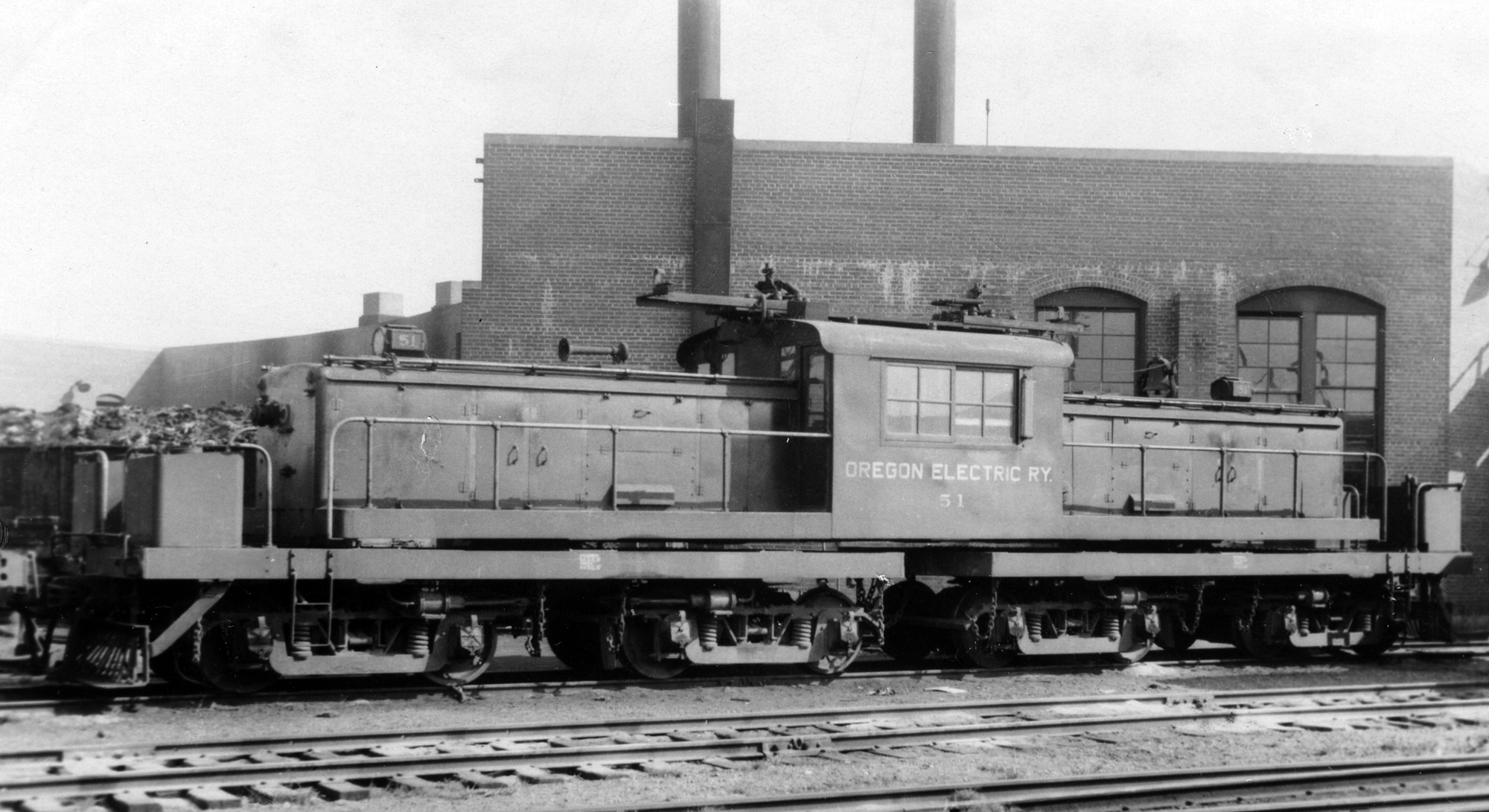- Home ›
- Interurbans ›
- Oregon
Oregon's Interurban History: Found Largely To The Northwest
Last revised: September 10, 2024
By: Adam Burns
Oregon contained a rather substantial network of interurban and streetcar systems, most of which were located in the Willamette Valley. As Drs. George Hilton and John Due note in their book, "The Electric Interurban Railways In America," the state boasted 432 miles of interurbans.
Most of this was operated by the Oregon Electric Railway; its main line stretched 110 miles from Portland to Eugene and operated a total of 190 miles. There was also the Portland Traction, Willamette Valley Southern Railway, United Railways, Southern Oregon Traction Company, and even an electrified branch maintained by the Southern Pacific which acted as an interurban.
This operation ran south and east of Portland linking the communities of Hillsboro, Whiteson, and Corvallis. As a result of the SP's healthy bottom line at that time, the company spent substantially to electrify these lines, utilizing 1,500-volt, DC and Pullman-built steel cars that weighed, on average, 100,000 pounds and featured raised pantographs instead of more traditional trolley poles.
The SP made the decision to electrify due to the Pacific Electric's success, provide competition against the Oregon Electric, and eliminate unprofitable local steam-powered service. To aid in the project, SP acquired the Portland, Eugene & Eastern as well as local streetcar systems serving Eugene and Portland. Interestingly, SP never electrified its lines directly into Eugene, going no further south than Corvallis. As automobile competition quickly eroded passenger traffic, SP ended all electrified service on October 5, 1929.
 One of the powerful motors built by Spokane, Portland & Seattle shop forces for the Oregon Electric Railway in the early 1940s; seen here is #51 which sported a center-cab setup and was later sold to the North Shore Line.
One of the powerful motors built by Spokane, Portland & Seattle shop forces for the Oregon Electric Railway in the early 1940s; seen here is #51 which sported a center-cab setup and was later sold to the North Shore Line.Pacific Power & Light Company
The Pacific Power & Light Company operated streetcar service in the City of Astoria. It remained in service until a massive downtown fire thoroughly destroyed the interurban's infrastructure causing it to close forever.
Portland Traction Company
The Portland Traction, commonly known as Pepco in its later days, moved significant amount of passengers although its system was only about 50 miles in length altogether.
Its history dates back to the earliest days of the industry when a line from Oregon City (just south of Portland) to Portland was completed and known as the East Side Railway, opening in February, 1893. A second route was opened ten years later, covering 36 miles and southeastward to Cazadero.
This line was primarily used to tap freight business and interchange with the Southern Pacific and Union Pacific. Later that decade the interurban continued to grow, reaching Troutdale and Gresham as well as Bull Run and Ruby via its ownership of the Mount Hood Railway & Power Company.
During the late 1920s and through the Great Depression the company was hard pressed and forced to cut back some of its lines. However, World War II allowed it to rebound to some degree but after the war's end passenger traffic continued to decline.
Interestingly, Pepco was the longest operated interurban in the country to carry on passenger operations when it finally ended these in 1958.
Its freight business carried on far longer although the company slowly eroded away, especially in the 1980s. The last remnants of the company were abandoned by 1990.
Oregon Electric Railway
The Oregon Electric Railway is the state's most famous interurban, mostly due to the company's many years of operation. It began operations in 1907 connecting Portland and Salem.
In 1910 it became part of the Spokane, Portland & Seattle Railway, which extended the main line to Eugene. While passenger service on the line only survive until 1933 freight service remained until the 1990s under then Burlington Northern control.
City & Suburban Railway
The City & Suburban Railway of 1891 was not Portland's first interurban but it was the first to consolidate many of the smaller lines that had sprung up in the city dating back to Portland Street Railway of 1872.
In 1904 the Portland Consolidated Railway came into existence when the Portland Railway and City & Suburban merged, the city's largest two interurbans up to that time.
A year later the line became known as the Portland Railway and by 1906 this company had merged with the Oregon Water Power & Railway to form the Portland Railway, Light & Power Company, the last remaining interurban in the city.
Over the subsequent years this system was known by several different names; the Mount Hood Railway & Power Company (1911); Portland Electric Power Company (1924); Portland Traction Company; and lastly the Portland Railroad & Terminal Division (1946). Streetcar service survived until 1950 when it was abandoned in favor of buses.
Willamette Valley Southern Railway
This interurban was owned by Portland Electric Power and connected with the Pepco at Oregon City, heading southward to reach Mt. Angel about 32 miles away.
It was a late operation and did not begin services until 1915. The company built up some freight service only to lose most of it during the Great Depression.
By that point passenger traffic had also severely declined and was completely discontinued by 1933. Total abandonment occurred in 1938.
United Railways
This interurban was one of the few to be owned by a main line railroad, in this case the Spokane, Portland & Seattle.
It began as the West Side & Suburban to serve Portland and later renamed as the Oregon Traction. In 1908 Unite Railways took over the company and its charter, opening a route a year later between Portland, Linnton, and Burlington covering about 12 miles.
Extensions by 1911 gave the company a 28-mile system and served Wilkesboro and Banks, including a massive 4,100-foot tunnel thanks to financing from parent SP&S.
In 1922 it took over the Portland, Astoria & Pacific but a year later slowly began to convert to standard steam locomotives. It continue to operate until World War II and was finally absorbed by the SP&S in 1943.
Southern Oregon Traction Company
This interurban was the only one located in the southern region of the state, opening a six-mile route between Medford and Jacksonville in 1890 as the Rogue River Valley Railway.
In 1915 the system became the Southern Oregon Traction but was in bankruptcy by 1918. It ended passenger service by 1922 and was abandoned by 1926.
Portland, Eugene & Eastern Railway
The Portland, Eugene & Eastern Railway, also known as the Red Electric, was a Southern Pacific subsidiary serving Bertha, Beaverton, Hillsboro, Forest Grove, McMinnville, Portland, Lake Oswego, Tualatin, Sherwood and Newburg.
The service lasted until 1927 at which point the SP was successful in discontinuing streetcars after several years of bottom line losses.
Recent Articles
-
Virginia Wine Tasting Train Rides
Jul 07, 25 10:45 PM
Wine tasting trains in Virginia provide just that—a unique experience that marries the romance of rail travel with the sensory delights of wine exploration. -
Vermont Wine Tasting Train Rides
Jul 07, 25 10:39 PM
Known for its stunning green mountains, charming small towns, and burgeoning wine industry, Vermont offers a unique experience that seamlessly blends all these elements: wine tasting train rides. -
Indiana's Whiskey Train Rides
Jul 07, 25 10:31 PM
Whether you're a local resident or a traveler looking to explore Indiana from a unique perspective, hopping on a whiskey train ride is a journey worth considering.


